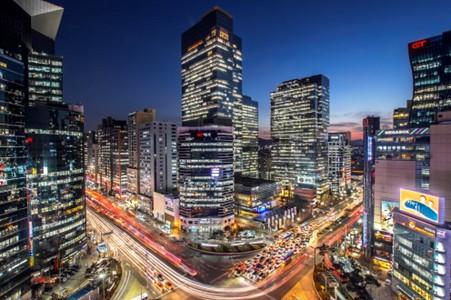Facts and figures
| GDP | $USD 1,712.79 billions |
| GDP per capita | $USD 33,121 |
| Currency | KRW (South Korean won ₩) |
| Imports | $USD 752.67 billions |
| Exports | $USD 753.55 billions |
| Main industries | electronics, telecommunications |
The ‘Know Your Region’ series is designed to support unit and individual professional military education on the Indo-Pacific region. It’s important for all serving members of our military to have a foundational knowledge of the countries and issues in the Indo-Pacific.
On this page:
- Summary
- Economy and GDP
- Trade – Imports and Exports
In the aftermath of the Korean War (1950-1953), South Korea was one of the poorest countries in the world. Most of the population relied on subsistence farming and there were scarce natural resources and industry. The economy heavily relied on foreign aid, particularly from the United States.
In 1961, General Park Chung-hee took power in a coup and instigated an era of export-oriented industrialisation (EOI). All kinds of foreign products were prohibited except raw materials. Through a series of five-year economic development plans, he was able to grow the manufacturing sector, from light industries such as textiles and footwear in the 1960’s to heavy industries including steel, shipbuilding, chemicals, and car manufacturing in the early 1970s. By the 1990s, South Korea had successfully diversified into high-tech industries, including semiconductors, electronics, display panels, and telecommunications.
The spearhead was the ‘chaebols’, large conglomerates run and controlled by wealthy families. They included Hyundai, Samsung, SK Group, and LG Corporation to name a few. To encourage rapid growth, the chaebols received generous state incentives such as tax breaks, lax labour laws, and access to low interest loans. While the chaebols are largely responsible for South Korea’s economic success, their dominance has led to concerns about monopolistic practices, corporate governance issues, and economic inequality. South Korea also received donations from the U.S during the Cold War, with foreign economic and military support continuing for some years.
During the 1970s, increased income disparity between the industrial and agricultural sectors became a problem, despite government efforts to raise farm income and improve rural areas. Inflation also rose to double digits, leading to a more conservative fiscal policy. One measure was to expand investments in public projects, such as roads and communications facilities, while promoting farm mechanisation. The strategy paid off and the 1980s saw a period of rapid growth, averaging an impressive 9.5 percent per year. The momentum slowed during the early 1990s; however, the economic outlook was positive, and high growth was expected to continue.
In July 1997, the Asian Financial Crisis caused the Korean won to rapidly depreciate along with most other Asian currencies. By January 1998, the government had shut down a third of Korea's merchant banks and the country's largest car manufacturer ‘Daewoo’ was dismantled. The recession was short lived however, and by December 1999, the government declared the crisis over.
South Korea faced a turning point in its economy in 2023, largely due to the global effects of the COVID-19 pandemic. Export of manufactured goods to mainland China had declined rapidly and private consumption had stalled. While information and communication technology made up 34% of South Korea's total 2022 exports, at the end of 2023, it had decreased to 24%. In addition to rising inflation, housing affordability and household debt had also become a big problem.
To revive South Korea’s struggling economy, the Ministry of Economy and Finance developed the ‘New Growth Strategy 4.0’ in August 2023. It included seven key guidelines:
- Foster AI semiconductor industries and build up a collaborative ecosystem between businesses.
- Dominate the global market of the Urban Air Mobility (UAM) industry.
- Secure clean hydrogen production technology via Water Electrolysis.
- Advance autonomous driving technologies.
- Promote the battery re-manufacturing and reuse markets.
- Expand the private sector led MyData Based Services.
- Streamline the ordering process of research equipment or facilities to alleviate administrative burdens.
Under the strategy, several initiatives have been launched, including the advancement of AI semiconductors, Urban Air Mobility, Autonomous vehicles, quantum technology, clean hydrogen production, and data driven healthcare.
Economy and Gross Domestic Product
South Korea is currently the world’s 12th-largest economy by nominal GDP, with an economy valued at over $1.7 trillion. The annual growth rate has averaged 8% year on year with a value of only 2.7 billion in 1962. It boasts a GDP per capita of approximately $36,000 (2024), placing it slightly higher than Japan. Since the early 1990s, South Korea has positioned itself as a leader in technological innovation, investing heavily in research and development (R&D). The country spends around 4.8% of its GDP on R&D, one of the highest rates globally. With a highly skilled workforce and strong government support for innovation, it continues to excel in artificial intelligence, biotechnology, and advanced manufacturing. South Korea is also a leader in the semiconductor industry, particularly through companies like Samsung and SK Hynix – making it vital for global supply chains. Unemployment remains relatively low, typically ranging between 3-5%, and the country has maintained a strong balance of trade surplus.
South Korea is one of the most digitally connected countries in the world with near-universal broadband access and 5G network expansion. E-commerce, fintech, and digital entertainment is booming, with companies like Naver, Kakao, and Coupang gaining international recognition. The cultural and entertainment industry, including K-pop, K-dramas, and online gaming has also emerged as a pillar of economic growth.

Image: Nightscape of Gangnam, Seoul. Source – Wikimedia
South Korea has a well-developed financial sector, with a stable banking system and a dynamic stock market. The Korea Exchange (KRX) is one of Asia’s major financial hubs, hosting large corporations and technology firms. The financial industry has embraced digital banking and fintech innovations such as cashless payments, blockchain applications, and AI-powered financial services.
Despite being reliant on fossil fuels, in recent years South Korea has committed to green energy initiatives, investing in renewable energy sources like solar and wind power. The government has also pledged to achieve carbon neutrality by 2050, pushing for the adoption of electric vehicles, hydrogen energy research, and stricter environmental regulations.
Trade – Imports and Exports
Trade accounts for a significant portion of South Korea’s GDP, with exports alone contributing around 40% of the total GDP. The reliance on trade means that fluctuations in global demand, supply chain disruptions, and geopolitical issues can have a substantial impact on the economy. In 2023, the South Korea’s total trade volume surpassed $1.2 trillion, making it the seventh-largest exporter and ninth-largest importer in the world.
South Korea’s economy is heavily dependent on a few key export industries – such as semiconductors, cars and auto parts, petrochemicals, ships, steel, consumer electronics, medical equipment, and precision instruments. Major export partners include China, the United States, Vietnam, and the European Union.
With few natural resources, South Korea relies on imports for raw materials, energy resources, and certain consumer goods. The country imports crude oil, natural gas, and coal to meet its energy demands, primarily from the Middle East, Australia, and the United States. It also imports industrial machinery, chemicals, and agricultural products such as wheat, corn, and soybeans. The balance of trade is relatively even with $683 billion worth of exports and $632 billion in imports (2023).
Following the impeachment of President Yoon Suk Yeol in December 2024, economic uncertainty has led to weakened consumer confidence and a decline in retail sales. After achieving a 2.0% growth rate in 2024, the Korea Development Institute (KDI) forecasts a growth rate of 1.6% for 2025, a 0.4% revision influenced by escalating U.S. trade tariffs and domestic political instability.
For more information on South Korea’s economy, see the resources below:
Video:
Articles:
- Perspiration and aspiration: behind South Korea's economic success – UNSW BusinessThink
- What Are Chaebol Structures in South Korea?
- Samsung, Shame, and Corporate Atonement
- OECD Economic Surveys: Korea 2024 | OECD
- SOUTH KOREA’S ECONOMIC MIRACLE | Facts and Details
- South Korea Ministry of Economy and Finance – Press Releases
- From K-pop to the KOSPI: trends shaping South Korea’s economy | Macquarie Group
Know your region
Know Your Region series gives you a shortcut to understanding other nations in the Indo-Pacific region.









